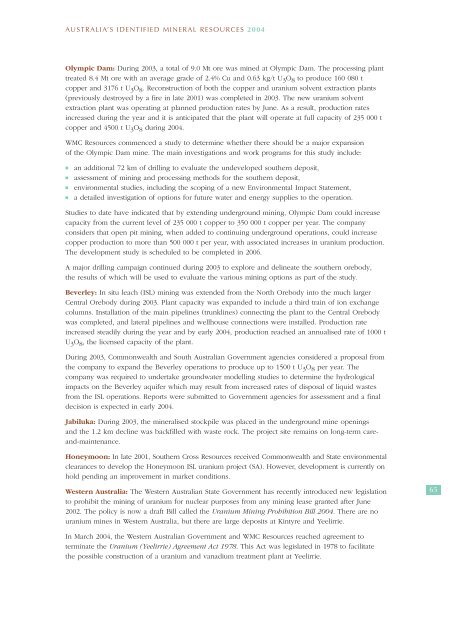australia's identified mineral resources 2004 - Geoscience Australia
australia's identified mineral resources 2004 - Geoscience Australia
australia's identified mineral resources 2004 - Geoscience Australia
Create successful ePaper yourself
Turn your PDF publications into a flip-book with our unique Google optimized e-Paper software.
AUSTRALIA’S IDENTIFIED MINERAL RESOURCES <strong>2004</strong><br />
Olympic Dam: During 2003, a total of 9.0 Mt ore was mined at Olympic Dam. The processing plant<br />
treated 8.4 Mt ore with an average grade of 2.4% Cu and 0.63 kg/t U 3 O 8 to produce 160 080 t<br />
copper and 3176 t U 3 O 8 . Reconstruction of both the copper and uranium solvent extraction plants<br />
(previously destroyed by a fire in late 2001) was completed in 2003. The new uranium solvent<br />
extraction plant was operating at planned production rates by June. As a result, production rates<br />
increased during the year and it is anticipated that the plant will operate at full capacity of 235 000 t<br />
copper and 4500 t U 3 O 8 during <strong>2004</strong>.<br />
WMC Resources commenced a study to determine whether there should be a major expansion<br />
of the Olympic Dam mine. The main investigations and work programs for this study include:<br />
■<br />
■<br />
■<br />
■<br />
an additional 72 km of drilling to evaluate the undeveloped southern deposit,<br />
assessment of mining and processing methods for the southern deposit,<br />
environmental studies, including the scoping of a new Environmental Impact Statement,<br />
a detailed investigation of options for future water and energy supplies to the operation.<br />
Studies to date have indicated that by extending underground mining, Olympic Dam could increase<br />
capacity from the current level of 235 000 t copper to 350 000 t copper per year. The company<br />
considers that open pit mining, when added to continuing underground operations, could increase<br />
copper production to more than 500 000 t per year, with associated increases in uranium production.<br />
The development study is scheduled to be completed in 2006.<br />
A major drilling campaign continued during 2003 to explore and delineate the southern orebody,<br />
the results of which will be used to evaluate the various mining options as part of the study.<br />
Beverley: In situ leach (ISL) mining was extended from the North Orebody into the much larger<br />
Central Orebody during 2003. Plant capacity was expanded to include a third train of ion exchange<br />
columns. Installation of the main pipelines (trunklines) connecting the plant to the Central Orebody<br />
was completed, and lateral pipelines and wellhouse connections were installed. Production rate<br />
increased steadily during the year and by early <strong>2004</strong>, production reached an annualised rate of 1000 t<br />
U 3 O 8 , the licensed capacity of the plant.<br />
During 2003, Commonwealth and South <strong>Australia</strong>n Government agencies considered a proposal from<br />
the company to expand the Beverley operations to produce up to 1500 t U 3 O 8 per year. The<br />
company was required to undertake groundwater modelling studies to determine the hydrological<br />
impacts on the Beverley aquifer which may result from increased rates of disposal of liquid wastes<br />
from the ISL operations. Reports were submitted to Government agencies for assessment and a final<br />
decision is expected in early <strong>2004</strong>.<br />
Jabiluka: During 2003, the <strong>mineral</strong>ised stockpile was placed in the underground mine openings<br />
and the 1.2 km decline was backfilled with waste rock. The project site remains on long-term careand-maintenance.<br />
Honeymoon: In late 2001, Southern Cross Resources received Commonwealth and State environmental<br />
clearances to develop the Honeymoon ISL uranium project (SA). However, development is currently on<br />
hold pending an improvement in market conditions.<br />
Western <strong>Australia</strong>: The Western <strong>Australia</strong>n State Government has recently introduced new legislation<br />
to prohibit the mining of uranium for nuclear purposes from any mining lease granted after June<br />
2002. The policy is now a draft Bill called the Uranium Mining Prohibition Bill <strong>2004</strong>. There are no<br />
uranium mines in Western <strong>Australia</strong>, but there are large deposits at Kintyre and Yeelirrie.<br />
65<br />
In March <strong>2004</strong>, the Western <strong>Australia</strong>n Government and WMC Resources reached agreement to<br />
terminate the Uranium (Yeelirrie) Agreement Act 1978. This Act was legislated in 1978 to facilitate<br />
the possible construction of a uranium and vanadium treatment plant at Yeelirrie.

















